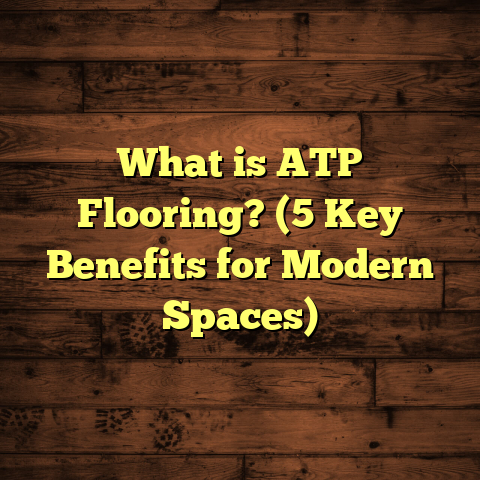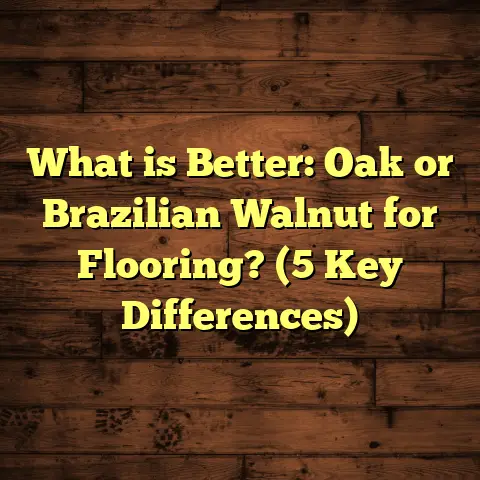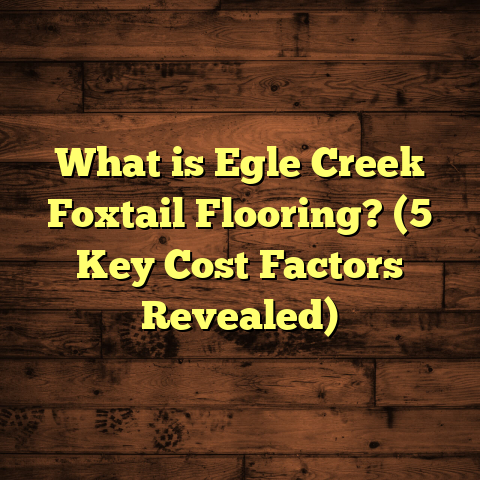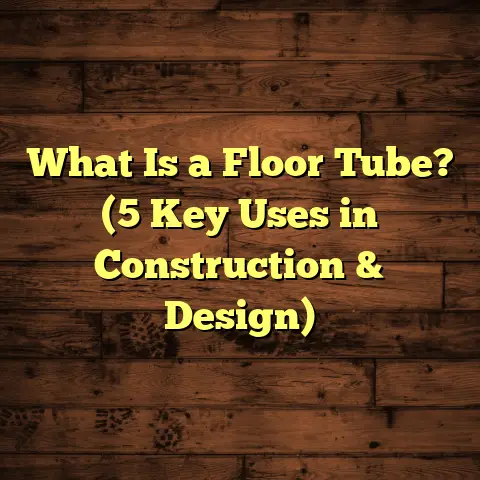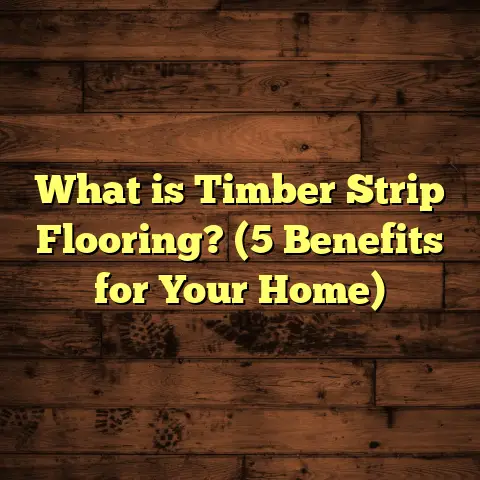What is HDF Engineered Bamboo Flooring? (5 Benefits for Sustainability)
You’re lounging in your living room after a long day, the soft glow of late afternoon sunlight spilling across your floors. You wiggle your toes, feeling the smoothness, the warmth radiating from those planks beneath your feet. It’s one of those rare moments where everything just feels right. Your floors look amazing, and you know they’re tough enough to handle whatever life throws at them—kids’ muddy shoes, pet claws, spills, and all the hustle and bustle.
But have you ever really thought about what kind of material makes that floor both stunning and durable? What it’s made of, how it’s made, and—most importantly—how it impacts the environment?
I’ve been in the flooring business for over a decade now. I’ve installed everything from traditional hardwood to laminate, vinyl, tile, and everything in between. But one product that has consistently impressed me—and my clients—is HDF engineered bamboo flooring. It’s a material that blends innovation and natural beauty while being gentle on the planet.
Let me take you on a journey through this flooring type: what it is, how it’s made, and why it’s an excellent choice if you care about sustainability. I’ll share my experiences, data-backed insights, and stories from real projects that highlight why this flooring is worth considering.
What is HDF Engineered Bamboo Flooring?
Alright, let’s break it down. What exactly is HDF engineered bamboo flooring?
At its simplest, it’s a flooring product made from two key components:
- A core layer made of HDF (High-Density Fiberboard)
- A thin top veneer layer made of real bamboo
Think of it as a sandwich where the dense fiberboard is the filling, providing strength and stability, and the bamboo veneer on top gives that natural bamboo look and feel.
What is HDF?
HDF stands for High-Density Fiberboard. It’s an engineered wood product created by breaking down hardwood or softwood residuals into wood fibers. These fibers are then combined with wax and resin, compressed under high heat and pressure to form dense panels.
Compared to Medium-Density Fiberboard (MDF), HDF is denser and stronger. This density makes it an excellent core material for flooring because:
- It resists warping and swelling better than solid wood.
- It has a smooth surface ideal for bonding veneers.
- It provides dimensional stability in changing climates.
Why Bamboo?
Bamboo is technically a grass but has qualities similar to hardwood trees. It grows fast, regenerates quickly after harvesting, and has a beautiful grain pattern.
Bamboo veneer used on engineered flooring is generally made by slicing thin layers from bamboo poles. Those thin layers are glued onto the HDF core to give the floor its distinctive look.
The Manufacturing Process
Understanding how these floors are made helps explain their benefits:
- Harvesting Bamboo: Bamboo poles are cut once mature (usually 3-5 years old).
- Veneer Preparation: The poles are steamed and flattened into thin strips or sheets.
- HDF Core Production: Wood fibers (sometimes recycled wood waste) are compressed into dense boards.
- Layering: The bamboo veneer is glued onto the HDF core under heat and pressure.
- Finishing: Planks are sanded smooth, coated with protective finishes (like polyurethane or UV-cured coatings), then cut into flooring boards.
- Quality Check: Each plank undergoes inspection to ensure consistent thickness, hardness, and finish quality.
This process results in planks that combine the natural beauty of bamboo with the engineered strength of HDF.
Why I’ve Grown to Prefer HDF Engineered Bamboo Flooring
Let me share a bit about my own journey with this flooring type.
Early in my career, I worked mostly with traditional hardwood floors. I loved the rich colors and natural textures but soon realized hardwood had its downsides—especially in humid climates. I saw floors buckle or warp when moisture levels fluctuated or experienced excessive expansion.
Then I started working more with bamboo flooring. Solid bamboo had many advantages—fast growth, unique grain patterns—but I still saw issues with moisture sensitivity when installed as solid planks.
When I discovered HDF engineered bamboo flooring about eight years ago, it felt like a game changer. The stability of the HDF core dramatically reduced problems related to moisture-induced movement. Plus, the bamboo veneer kept that natural aesthetic my clients loved.
I’ve installed this flooring in dozens of homes—from cozy apartments to large family houses— and even commercial spaces like yoga studios and green office buildings.
One homeowner told me their floor looked just as beautiful after two years of their energetic kids’ constant running around as it did on day one. Another client was thrilled because the floor didn’t warp despite living near the coast where humidity swings are common.
These experiences convinced me that HDF engineered bamboo flooring isn’t just a trend—it’s a smart, durable choice that aligns well with modern lifestyles and environmental concerns.
5 Benefits for Sustainability
Now let’s get to something that really matters: sustainability.
You might wonder — how exactly does this flooring help the environment? Why choose this over traditional hardwood or laminate?
Here are five key sustainability benefits of HDF engineered bamboo flooring:
1. Bamboo Is an Exceptionally Fast-Growing Renewable Resource
One of the biggest advantages of bamboo is its growth rate. Unlike hardwood trees, which can take decades to mature (20-50 years for oaks or maples), bamboo can reach maturity in just 3-5 years.
That means bamboo can be harvested frequently without deforestation concerns or long recovery times.
According to research by the World Bamboo Organization:
- Bamboo can grow up to 91 cm (35 inches) per day under optimal conditions.
- A hectare of bamboo plantation can yield around 40 tons annually.
- Bamboo forests regenerate naturally after harvesting without needing replanting.
This rapid growth cycle makes bamboo one of the most renewable building materials available.
In contrast, estimates show that hardwood forests around the world regenerate at only 1-2% per year, making their harvest less sustainable long term.
By using bamboo veneer on an engineered core made partly from recycled wood fibers, manufacturers reduce reliance on slow-growing trees and help conserve forest ecosystems.
2. Lower Carbon Footprint Throughout Its Life Cycle
Carbon footprint refers to the total greenhouse gas emissions caused directly or indirectly by a product, including extraction, manufacturing, transportation, usage, and disposal.
Bamboo’s fast growth helps reduce carbon emissions because it absorbs carbon dioxide quickly, acting as a carbon sink.
A study published in the Journal of Cleaner Production compared life cycle assessments (LCAs) of various flooring types and found:
- Engineered bamboo flooring had up to 30% less embodied energy than traditional solid hardwood floors.
- Bamboo sequesters approximately 12 tons of CO₂ per hectare annually.
- Using recycled fibers in HDF cores further cuts down emissions by reducing logging demand.
I’ve seen clients who closely follow sustainability metrics appreciate these numbers because floors often represent a significant portion of a building’s carbon footprint.
Choosing HDF engineered bamboo flooring contributes to lowering greenhouse gas emissions, helping fight climate change one step at a time.
3. Efficient Use of Raw Materials Minimizes Waste
Traditional solid hardwood floors require thick planks cut from large logs. During milling and shaping, waste rates can be as high as 30% due to offcuts, knots, or defects.
On the other hand, engineered bamboo flooring optimizes material use:
- Thin bamboo veneers use smaller strips of bamboo efficiently.
- The HDF core is made from wood fibers including sawdust and wood chips that would otherwise be discarded.
- Production methods allow precise cutting with minimal scrap material.
Manufacturers report that engineered products like this reduce raw material waste by approximately 20-40% compared to solid wood flooring production.
From what I’ve observed working with suppliers and installers, this means less pressure on forests and better resource utilization.
If you care about reducing environmental impact at every stage, this efficient use of materials is a big plus.
4. Durability Means Floors Last Longer With Less Maintenance
Sustainability also means making choices that last over time. There’s no point in picking a “green” floor if it needs replacing every few years—that creates excess waste and consumes more resources.
HDF engineered bamboo floors offer excellent durability due to:
- The dense fiberboard core that resists warping and cracking.
- Protective finishes that shield against scratches, stains, and moisture.
- Dimensional stability across humidity fluctuations.
In my experience installing these floors in busy homes with kids and pets, they hold up remarkably well even under heavy traffic.
One family I worked with had three young kids and two dogs; after four years, their floors still looked almost new with only occasional cleaning and polish needed.
This durability means fewer resources spent on repairs or replacements, lowering your home’s overall environmental footprint over its lifetime.
5. Healthier Indoor Air Quality With Low VOC Emissions
Indoor air quality (IAQ) is often overlooked but plays a vital role in healthy living environments.
Many traditional flooring materials emit volatile organic compounds (VOCs) during and after installation. These chemicals can cause headaches, allergies, respiratory problems, or worse with long-term exposure.
The good news is that many modern HDF engineered bamboo products use:
- Low-VOC adhesives and finishes certified by programs like GREENGUARD or FloorScore.
- Stable core materials that resist mold growth by limiting moisture absorption.
- Natural bamboo veneers free from synthetic dyes or treatments in many cases.
I’ve installed this flooring for clients sensitive to allergens or asthma sufferers, and they reported noticeable improvements in air quality compared to previous floors.
Choosing products with verified low emissions aligns indoor health with environmental goals, making it a win-win for families.
Personal Case Studies & Real-Life Examples
Let me share some stories from my projects that highlight these points more concretely:
Family Home Renovation in Portland
A young couple wanted sustainable materials throughout their new home renovation. They were particularly concerned about durability since they had two toddlers active all day long.
After discussing options, we settled on HDF engineered bamboo flooring due to its stability and fast renewability.
Two years later they emailed me excited: “The floor looks amazing despite spills, scratches, and sticky fingers everywhere! Plus we love knowing it’s eco-friendly.”
They even reported fewer dust mites due to low VOC finishes helping allergy symptoms.
Yoga Studio in San Francisco
A local yoga studio wanted an eco-friendly floor that was both beautiful and able to withstand daily foot traffic from barefoot classes.
We installed HDF engineered bamboo planks finished with natural oils rather than synthetic coatings. The client appreciated the natural scent release from bamboo combined with easy cleaning routines.
After six months they reported no signs of wear or moisture damage despite frequent mopping, and customers complimented the warm inviting feel underfoot during sessions.
This project contributed toward their LEED certification goals thanks to the sustainable materials used.
Commercial Office Space in Seattle
An environmentally conscious tech company aimed to create a green workspace without sacrificing style or durability.
We used HDF engineered bamboo flooring paired with reclaimed wood furniture. The client was thrilled with how well the floor resisted dents from rolling chairs and stayed looking fresh throughout their high-traffic conference rooms.
They highlighted this choice as part of their corporate sustainability report, showcasing how building materials can align with values while performing practically.
Technical Insights Into Installation & Performance
Understanding how these floors perform during installation helps explain why they work so well over time.
Installation Methods
HDF engineered bamboo floors typically come as:
- Floating floors: Planks click together over underlayment without glue or nails.
- Glue-down: Adhesive applied directly to subfloor for permanent bond.
- Nail-down: Less common but possible over wood subfloors for added security.
Floating installation is popular for DIYers and professionals alike because it:
- Allows expansion space to prevent buckling.
- Speeds up installation time significantly.
- Can be installed over many subfloor types including concrete or plywood.
In my experience guiding homeowners through DIY installs, floating floors provide a perfect balance between ease and durability if done right.
Moisture Resistance & Climate Adaptability
One concern people have with natural materials is moisture damage. Here’s what I’ve learned:
- The HDF core has low water absorption compared to solid wood.
- Bamboo veneer is naturally harder than many hardwoods but still needs protective finish.
- Proper acclimation before installation (typically 48 hours indoors) reduces expansion surprises.
- Using moisture barriers under concrete slabs protects against ground moisture intrusion.
In coastal or humid regions where I’ve worked extensively, these floors maintain dimensional stability far better than solid hardwood alternatives.
Maintenance Tips Based on Experience
To keep your floor looking great for decades:
- Sweep or vacuum regularly to remove grit that can scratch finish.
- Clean spills promptly using damp cloths; avoid soaking floors with water.
- Use manufacturer-recommended cleaners designed for engineered floors.
- Place furniture pads under heavy items to prevent denting.
- Avoid harsh chemicals or abrasive scrubbers that wear away protective coatings.
I’ve seen clients who followed simple care routines enjoy pristine floors after 10+ years without refinishing needs.
Comparing HDF Engineered Bamboo Flooring With Other Options
You might be wondering how this compares with other popular floor types like solid hardwood, laminate, vinyl plank, or traditional solid bamboo floors. Here’s a quick overview:
| Flooring Type | Sustainability | Durability | Maintenance | Cost Range | Aesthetic Appeal |
|---|---|---|---|---|---|
| Solid Hardwood | Slow renewability; higher carbon footprint | Can warp; sensitive to moisture | Refinishing required | $$$ – $$$$ | Classic & rich |
| Laminate Flooring | Made partly from wood waste; some plastic content | Scratch resistant; not repairable | Easy; but can’t refinish | $ – $$ | Imitates wood |
| Vinyl Plank Flooring | Petroleum-based; less eco-friendly | Waterproof; durable | Easy | $ – $$ | Wide variety |
| Solid Bamboo Flooring | Fast renewability | Hard but prone to moisture damage | Moderate | $$ – $$$ | Natural & unique |
| HDF Engineered Bamboo | Fast renewability + recycled core | Stable & durable | Moderate; low VOC care | $$ – $$$ | Natural + modern |
From experience advising clients: If you want real wood look plus eco benefits but worry about stability, HDF engineered bamboo strikes an excellent balance between nature and tech innovation.
Exploring Environmental Certifications & Standards
A topic often overlooked but crucial for sustainability-conscious buyers:
Many manufacturers produce HDF engineered bamboo flooring certified by third-party organizations such as:
- Forest Stewardship Council (FSC): Ensures responsible sourcing of raw materials.
- GREENGUARD: Certifies low chemical emissions for healthier indoor air.
- LEED Credit Eligibility: Flooring using rapidly renewable materials like bamboo can contribute points toward LEED green building certification.
When choosing products, look for these certifications as proof that manufacturers meet environmental standards beyond marketing claims.
I always recommend clients verify certifications before purchase—they tell you more than just “eco-friendly” labels do.
Economic & Budget Considerations
You’re probably asking: how much does this cost compared to other options?
Prices vary depending on brand, finish type, plank size, and installation method but here are rough estimates per square foot (material only):
- Solid hardwood: $8 – $15+
- Laminate: $2 – $6
- Vinyl plank: $3 – $7
- Solid bamboo: $5 – $10
- HDF Engineered Bamboo: $6 – $12
Installation costs add another $2 – $6 per square foot depending on complexity and region.
Though slightly higher than laminate or vinyl upfront, the durability and sustainability benefits often justify the investment over time— especially if you plan on staying in your home long-term or want resale appeal tied to green features.
Final Thoughts on Choosing Flooring That Fits Your Values
Flooring isn’t just something you walk on—it shapes how your home feels every day. Choosing materials thoughtfully affects your comfort, health, budget, and planet all at once.
From my perspective: HDF engineered bamboo flooring offers an impressive combination of renewable sourcing, durability through smart engineering, lower emissions throughout production, efficient use of raw materials, and healthier indoor air quality—all wrapped in natural beauty that lasts decades.
If you’re someone who cares about where your building materials come from, how they impact global resources, AND wants something practical for daily life, this type of flooring deserves serious consideration.
Whenever friends or clients ask me for recommendations on sustainable yet stylish floors, this is often my first suggestion because it ticks so many boxes I value personally and professionally.
If you want help selecting specific products or tips for installation and maintenance, just reach out—I’m happy to share everything I’ve learned firsthand along the way!
